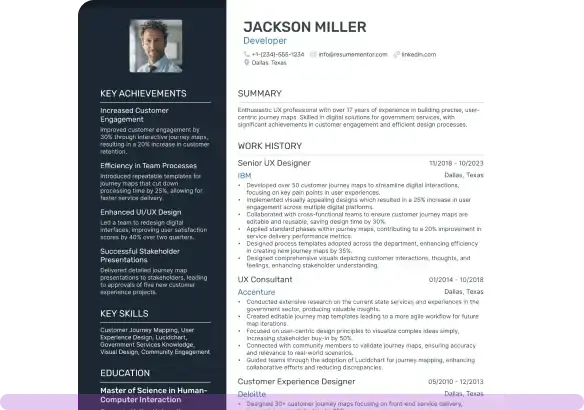Translator Resume Examples

Mar 31, 2025
|
12 min read
Unlock translation opportunities with the perfect resume. This simple guide helps you speak the language of employers, turning your skills into a story worth telling. Remember, your resume should say "hire me", not just "bonjour".
Rated by 348 people
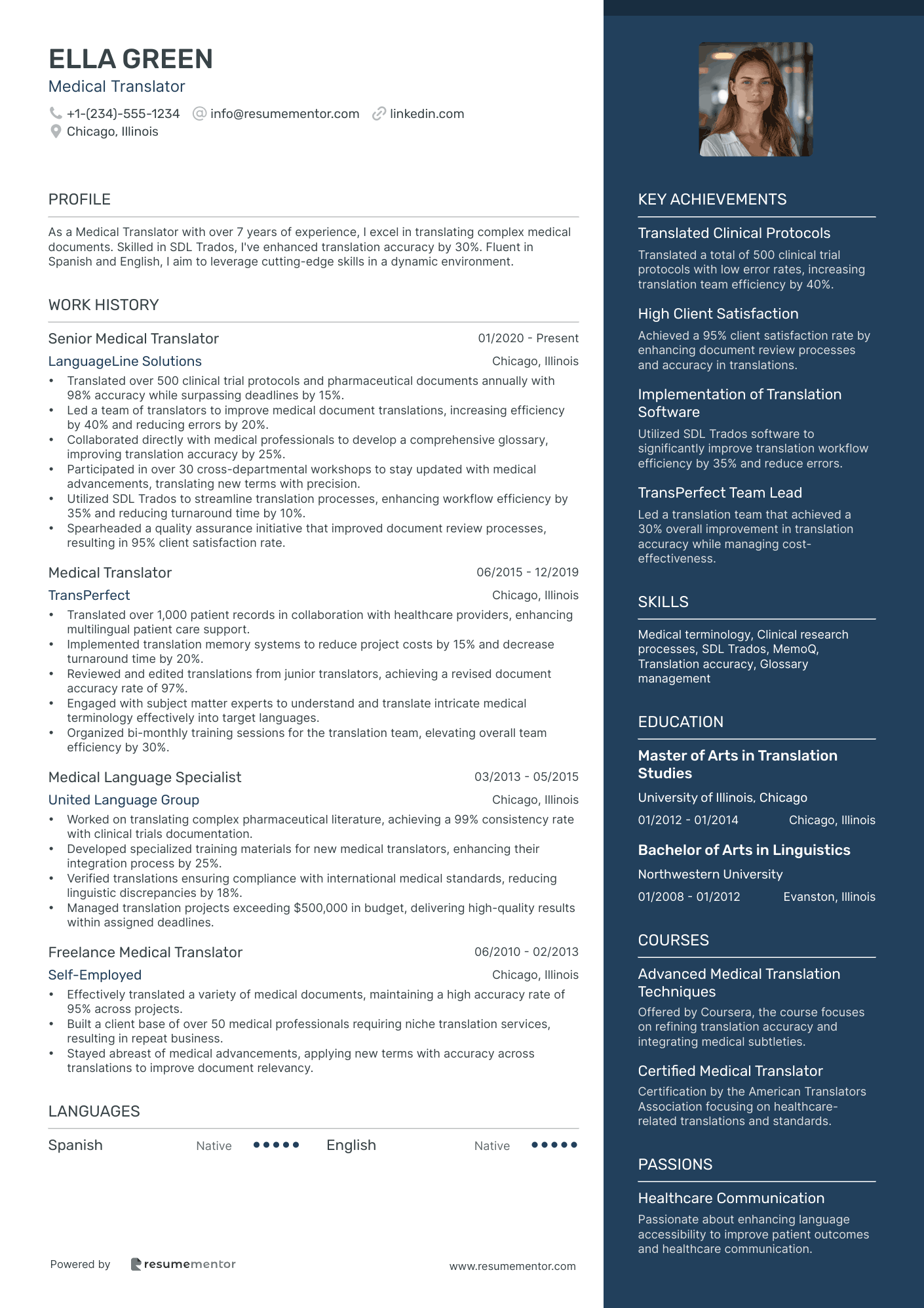
Medical Translator
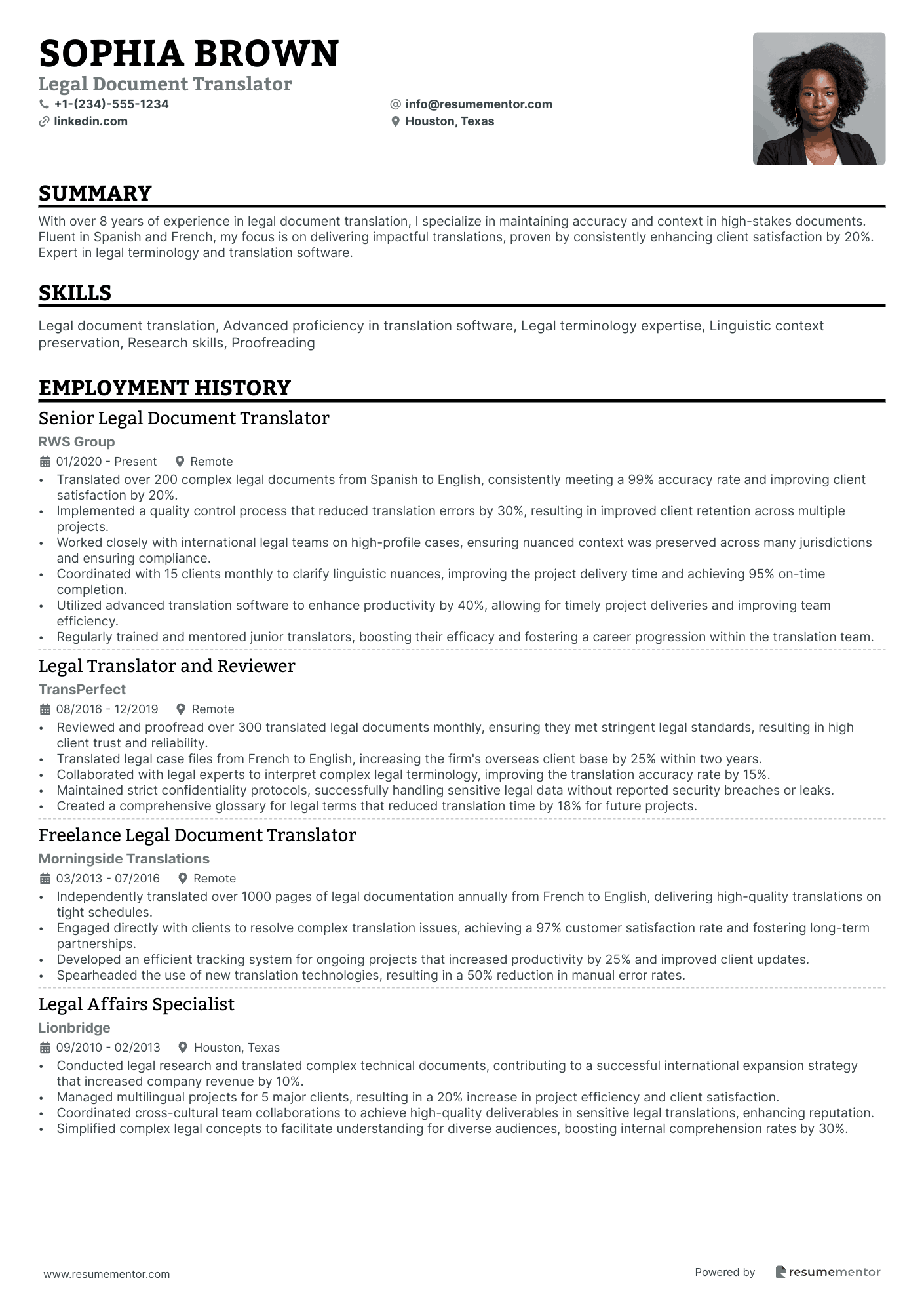
Legal Document Translator
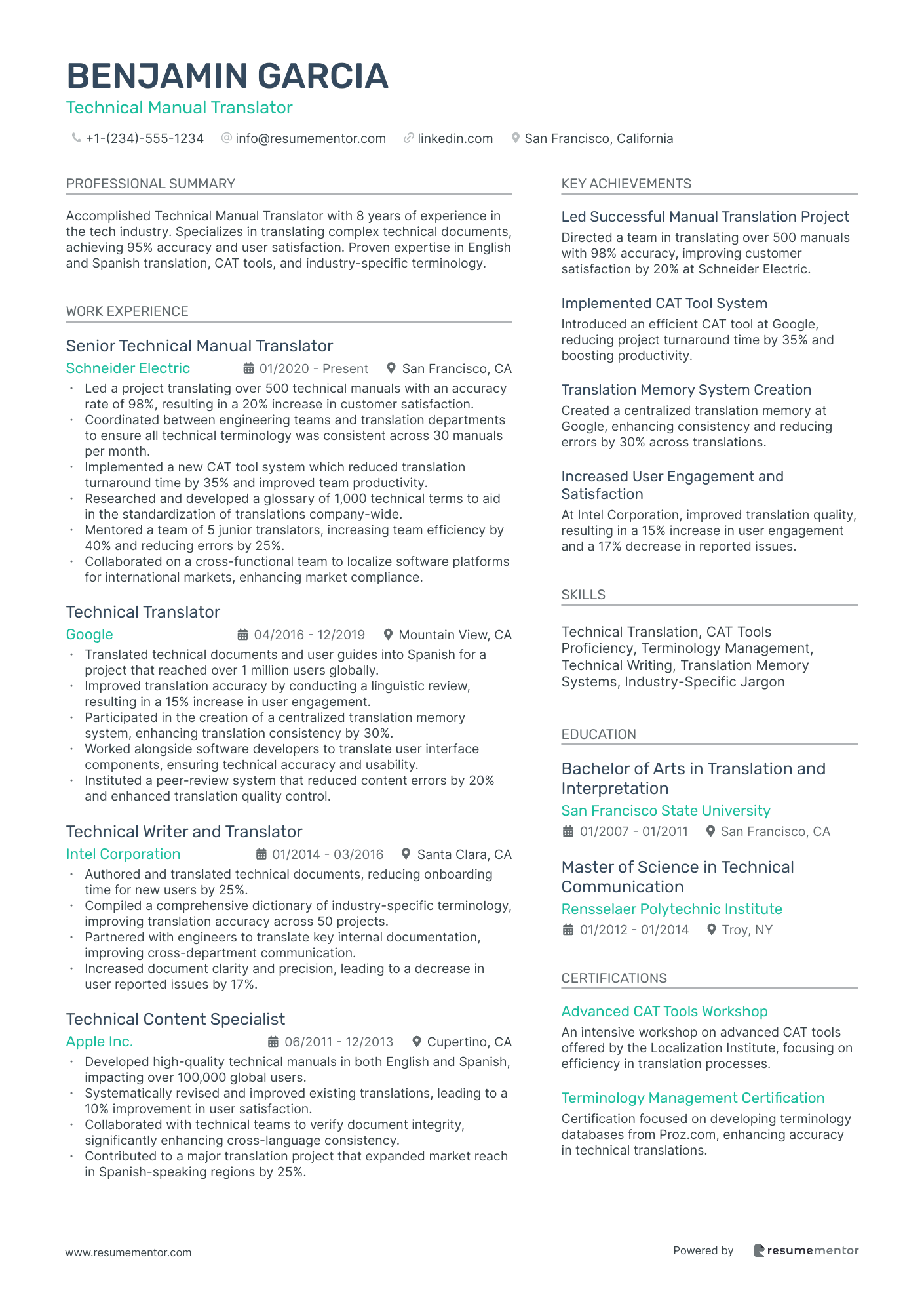
Technical Manual Translator
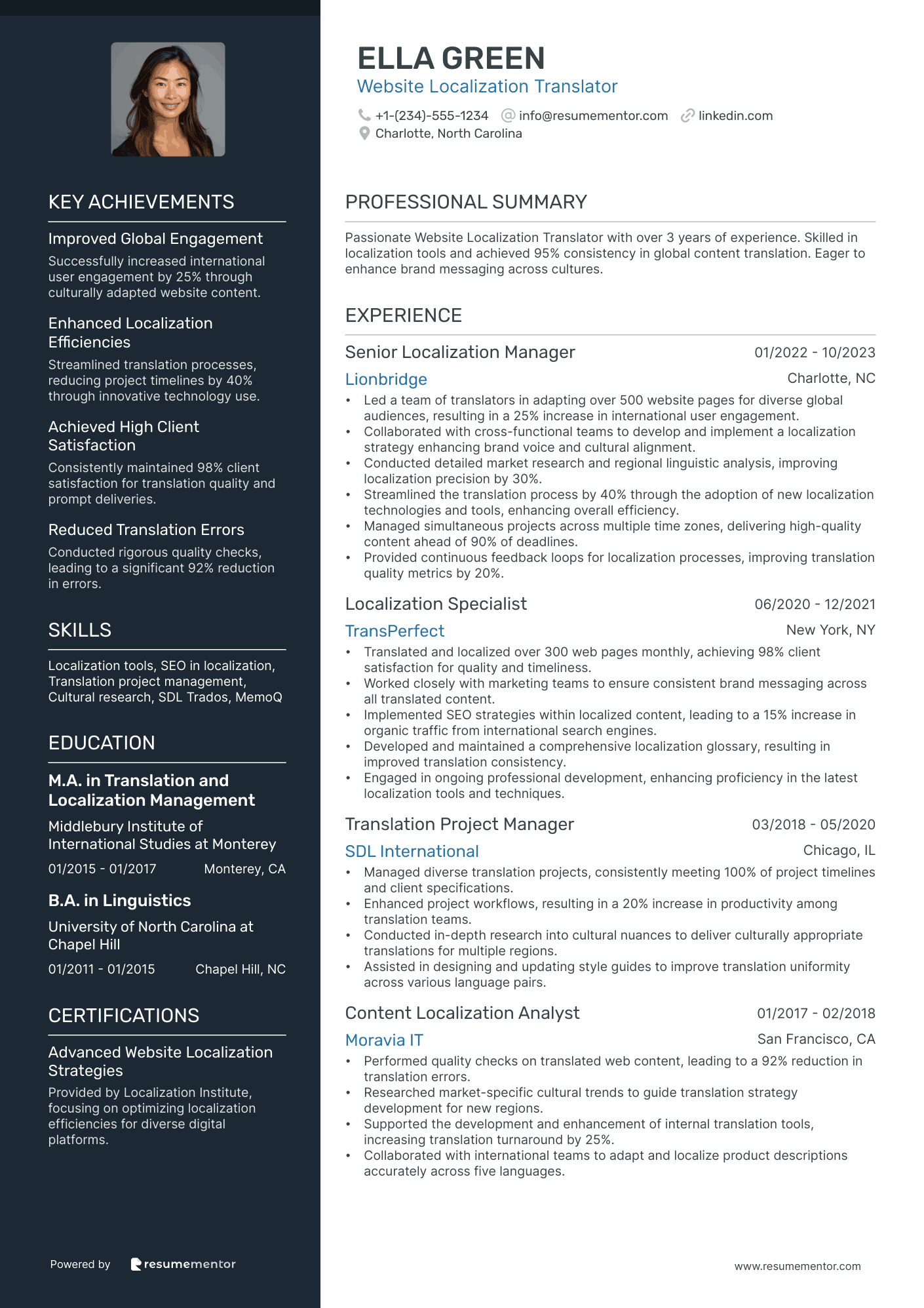
Website Localization Translator
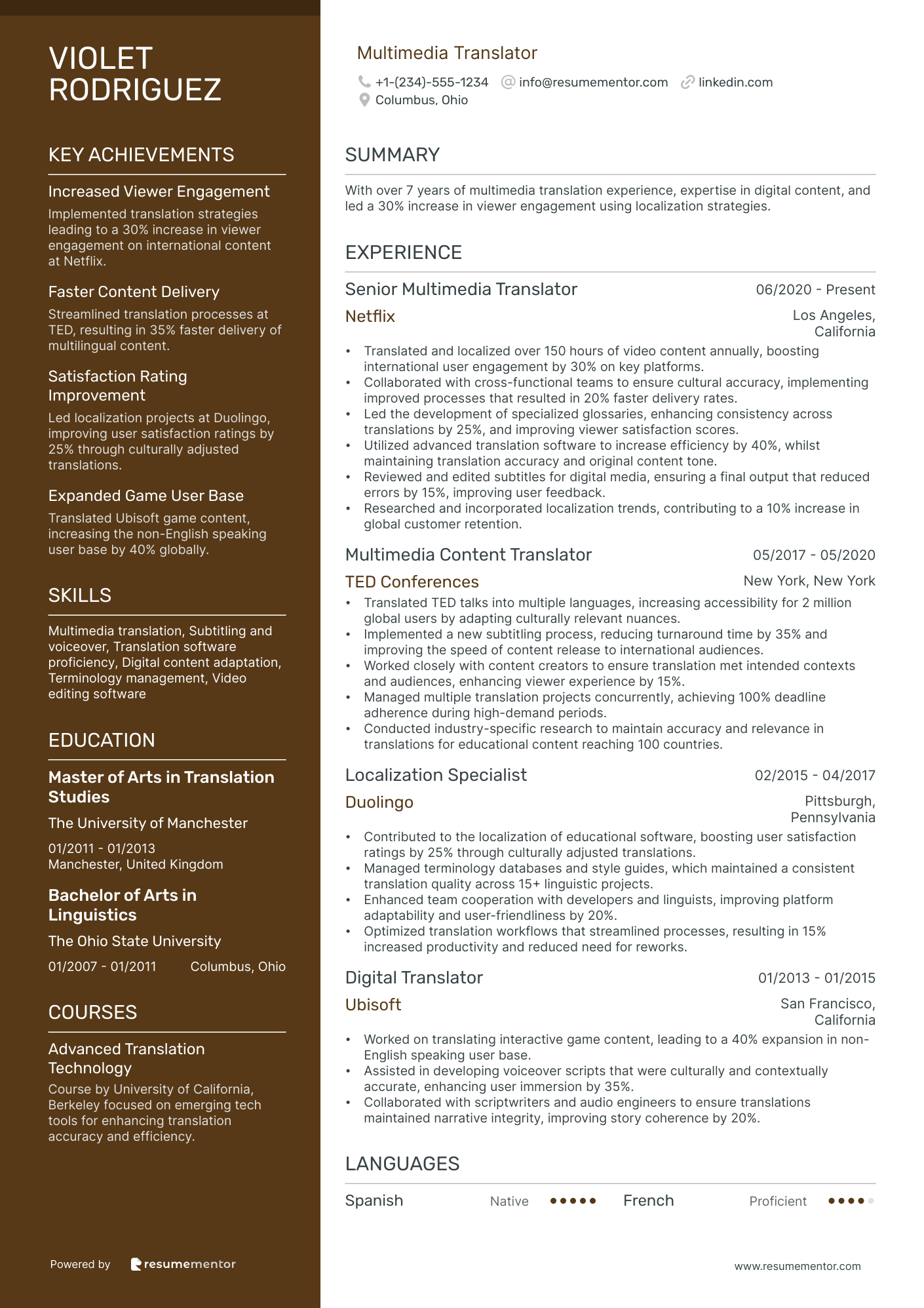
Multimedia Translator
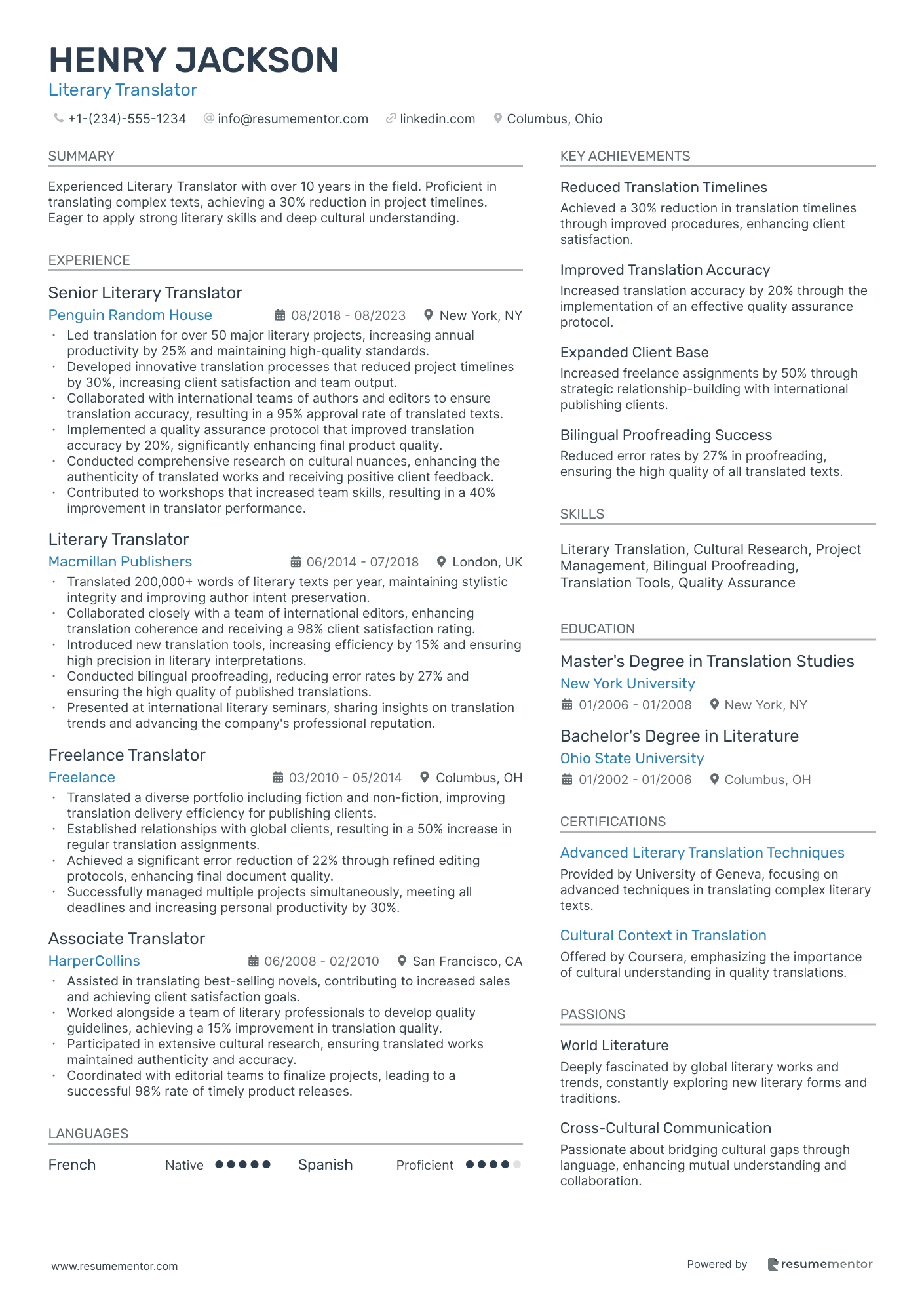
Literary Translator
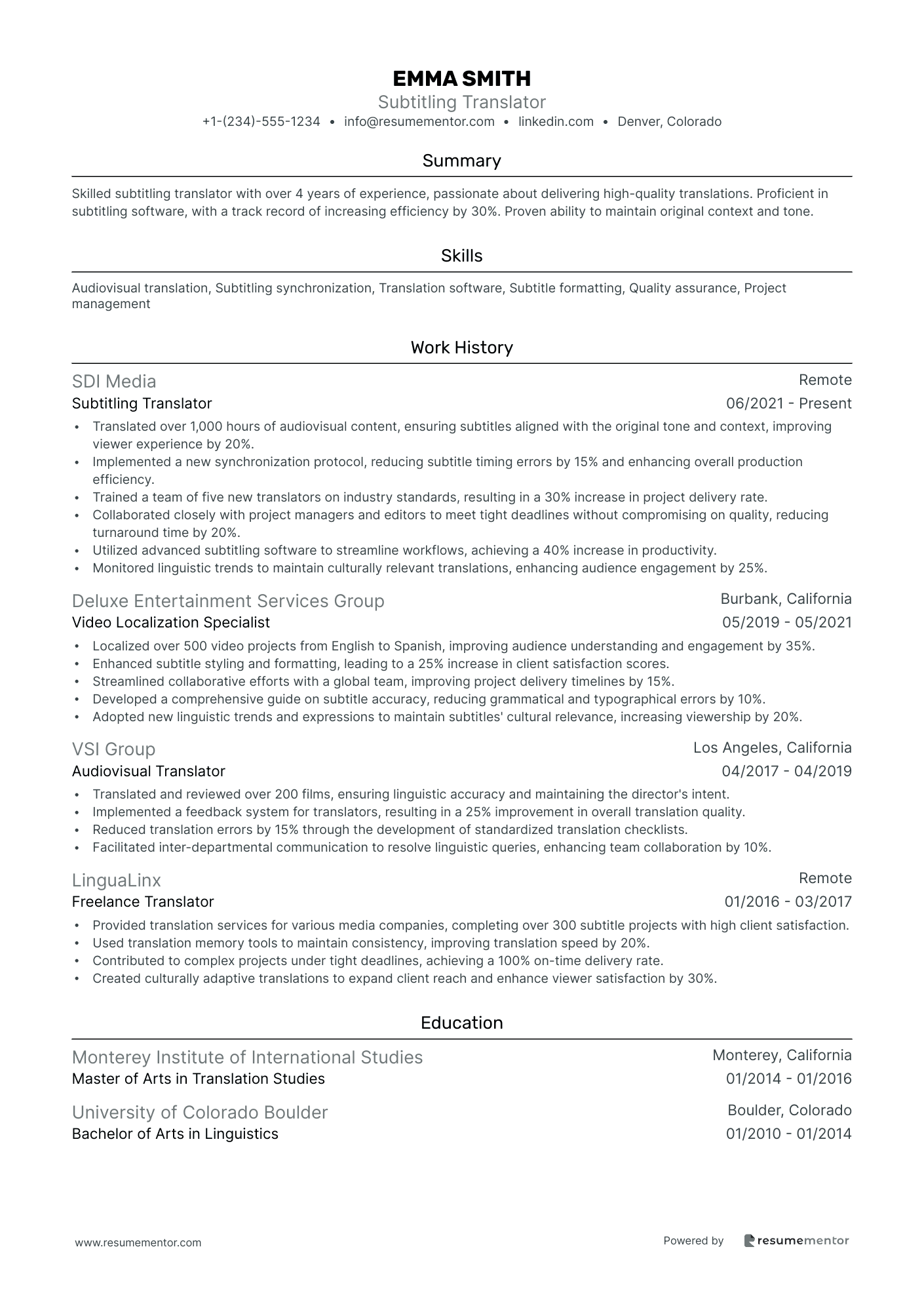
Subtitling Translator
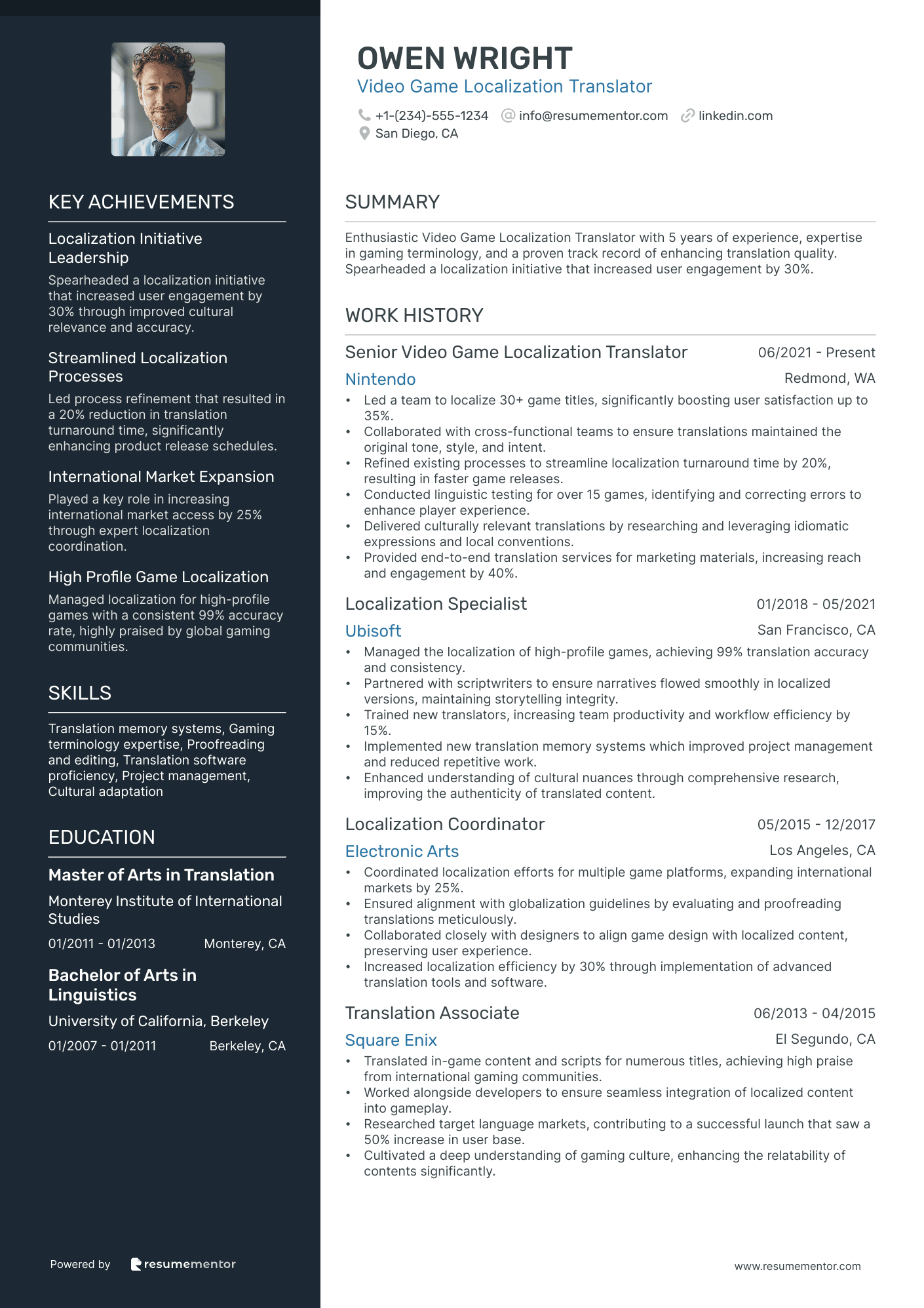
Video Game Localization Translator
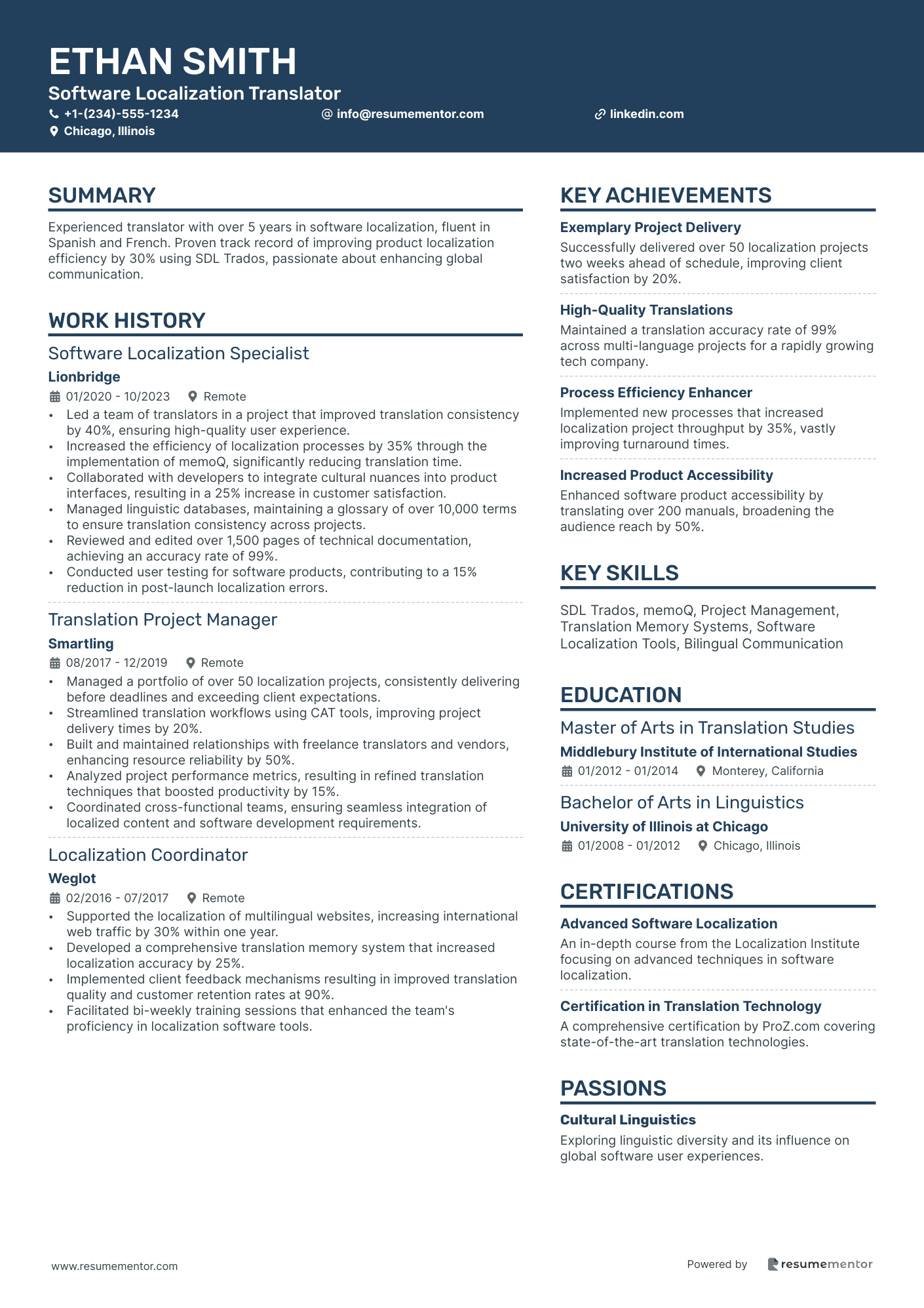
Software Localization Translator
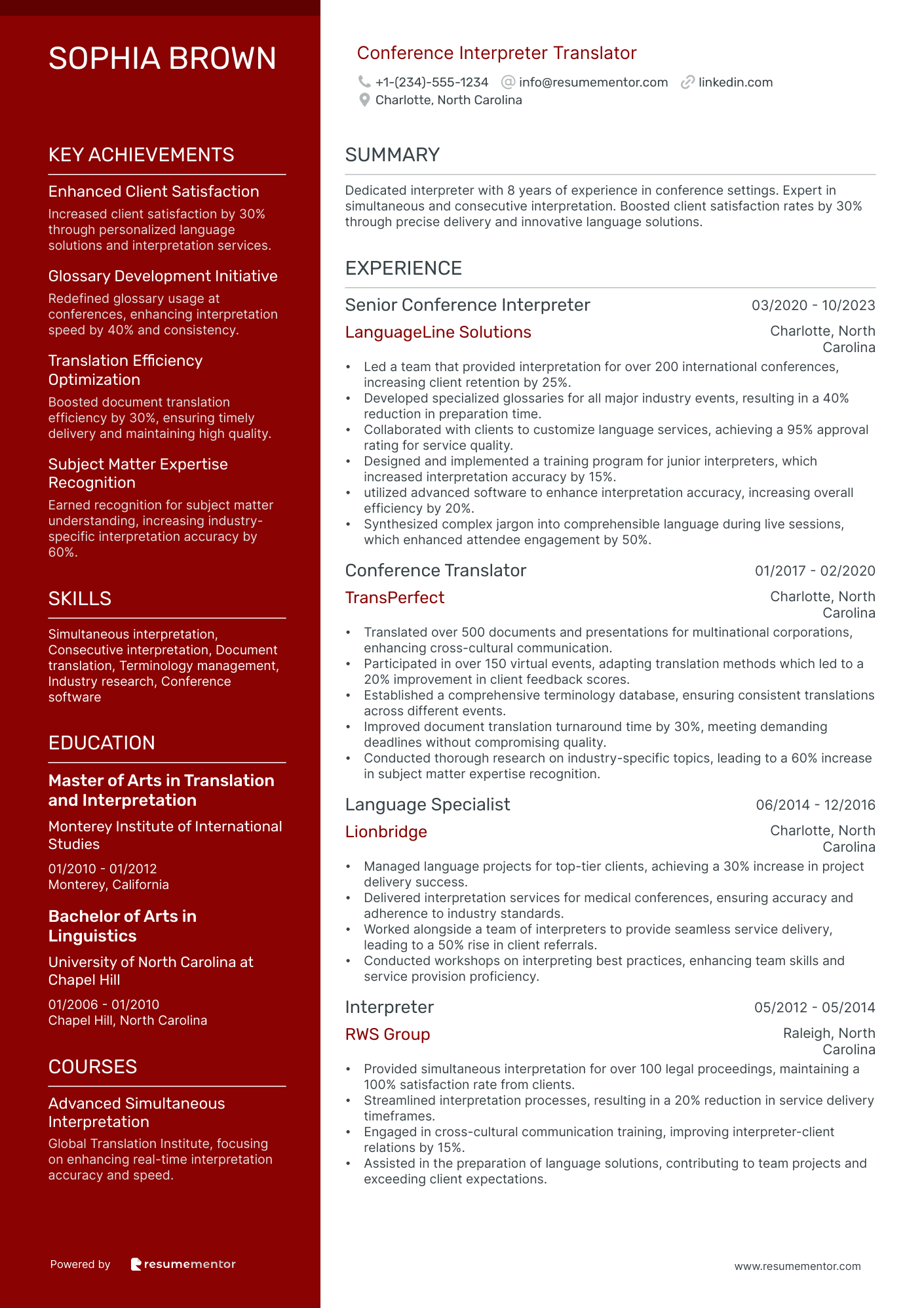
Conference Interpreter Translator

Medical Translator resume sample
- •Translated over 500 clinical trial protocols and pharmaceutical documents annually with 98% accuracy while surpassing deadlines by 15%.
- •Led a team of translators to improve medical document translations, increasing efficiency by 40% and reducing errors by 20%.
- •Collaborated directly with medical professionals to develop a comprehensive glossary, improving translation accuracy by 25%.
- •Participated in over 30 cross-departmental workshops to stay updated with medical advancements, translating new terms with precision.
- •Utilized SDL Trados to streamline translation processes, enhancing workflow efficiency by 35% and reducing turnaround time by 10%.
- •Spearheaded a quality assurance initiative that improved document review processes, resulting in 95% client satisfaction rate.
- •Translated over 1,000 patient records in collaboration with healthcare providers, enhancing multilingual patient care support.
- •Implemented translation memory systems to reduce project costs by 15% and decrease turnaround time by 20%.
- •Reviewed and edited translations from junior translators, achieving a revised document accuracy rate of 97%.
- •Engaged with subject matter experts to understand and translate intricate medical terminology effectively into target languages.
- •Organized bi-monthly training sessions for the translation team, elevating overall team efficiency by 30%.
- •Worked on translating complex pharmaceutical literature, achieving a 99% consistency rate with clinical trials documentation.
- •Developed specialized training materials for new medical translators, enhancing their integration process by 25%.
- •Verified translations ensuring compliance with international medical standards, reducing linguistic discrepancies by 18%.
- •Managed translation projects exceeding $500,000 in budget, delivering high-quality results within assigned deadlines.
- •Effectively translated a variety of medical documents, maintaining a high accuracy rate of 95% across projects.
- •Built a client base of over 50 medical professionals requiring niche translation services, resulting in repeat business.
- •Stayed abreast of medical advancements, applying new terms with accuracy across translations to improve document relevancy.
Legal Document Translator resume sample
- •Translated over 200 complex legal documents from Spanish to English, consistently meeting a 99% accuracy rate and improving client satisfaction by 20%.
- •Implemented a quality control process that reduced translation errors by 30%, resulting in improved client retention across multiple projects.
- •Worked closely with international legal teams on high-profile cases, ensuring nuanced context was preserved across many jurisdictions and ensuring compliance.
- •Coordinated with 15 clients monthly to clarify linguistic nuances, improving the project delivery time and achieving 95% on-time completion.
- •Utilized advanced translation software to enhance productivity by 40%, allowing for timely project deliveries and improving team efficiency.
- •Regularly trained and mentored junior translators, boosting their efficacy and fostering a career progression within the translation team.
- •Reviewed and proofread over 300 translated legal documents monthly, ensuring they met stringent legal standards, resulting in high client trust and reliability.
- •Translated legal case files from French to English, increasing the firm's overseas client base by 25% within two years.
- •Collaborated with legal experts to interpret complex legal terminology, improving the translation accuracy rate by 15%.
- •Maintained strict confidentiality protocols, successfully handling sensitive legal data without reported security breaches or leaks.
- •Created a comprehensive glossary for legal terms that reduced translation time by 18% for future projects.
- •Independently translated over 1000 pages of legal documentation annually from French to English, delivering high-quality translations on tight schedules.
- •Engaged directly with clients to resolve complex translation issues, achieving a 97% customer satisfaction rate and fostering long-term partnerships.
- •Developed an efficient tracking system for ongoing projects that increased productivity by 25% and improved client updates.
- •Spearheaded the use of new translation technologies, resulting in a 50% reduction in manual error rates.
- •Conducted legal research and translated complex technical documents, contributing to a successful international expansion strategy that increased company revenue by 10%.
- •Managed multilingual projects for 5 major clients, resulting in a 20% increase in project efficiency and client satisfaction.
- •Coordinated cross-cultural team collaborations to achieve high-quality deliverables in sensitive legal translations, enhancing reputation.
- •Simplified complex legal concepts to facilitate understanding for diverse audiences, boosting internal comprehension rates by 30%.
Technical Manual Translator resume sample
- •Led a project translating over 500 technical manuals with an accuracy rate of 98%, resulting in a 20% increase in customer satisfaction.
- •Coordinated between engineering teams and translation departments to ensure all technical terminology was consistent across 30 manuals per month.
- •Implemented a new CAT tool system which reduced translation turnaround time by 35% and improved team productivity.
- •Researched and developed a glossary of 1,000 technical terms to aid in the standardization of translations company-wide.
- •Mentored a team of 5 junior translators, increasing team efficiency by 40% and reducing errors by 25%.
- •Collaborated on a cross-functional team to localize software platforms for international markets, enhancing market compliance.
- •Translated technical documents and user guides into Spanish for a project that reached over 1 million users globally.
- •Improved translation accuracy by conducting a linguistic review, resulting in a 15% increase in user engagement.
- •Participated in the creation of a centralized translation memory system, enhancing translation consistency by 30%.
- •Worked alongside software developers to translate user interface components, ensuring technical accuracy and usability.
- •Instituted a peer-review system that reduced content errors by 20% and enhanced translation quality control.
- •Authored and translated technical documents, reducing onboarding time for new users by 25%.
- •Compiled a comprehensive dictionary of industry-specific terminology, improving translation accuracy across 50 projects.
- •Partnered with engineers to translate key internal documentation, improving cross-department communication.
- •Increased document clarity and precision, leading to a decrease in user reported issues by 17%.
- •Developed high-quality technical manuals in both English and Spanish, impacting over 100,000 global users.
- •Systematically revised and improved existing translations, leading to a 10% improvement in user satisfaction.
- •Collaborated with technical teams to verify document integrity, significantly enhancing cross-language consistency.
- •Contributed to a major translation project that expanded market reach in Spanish-speaking regions by 25%.
Website Localization Translator resume sample
- •Led a team of translators in adapting over 500 website pages for diverse global audiences, resulting in a 25% increase in international user engagement.
- •Collaborated with cross-functional teams to develop and implement a localization strategy enhancing brand voice and cultural alignment.
- •Conducted detailed market research and regional linguistic analysis, improving localization precision by 30%.
- •Streamlined the translation process by 40% through the adoption of new localization technologies and tools, enhancing overall efficiency.
- •Managed simultaneous projects across multiple time zones, delivering high-quality content ahead of 90% of deadlines.
- •Provided continuous feedback loops for localization processes, improving translation quality metrics by 20%.
- •Translated and localized over 300 web pages monthly, achieving 98% client satisfaction for quality and timeliness.
- •Worked closely with marketing teams to ensure consistent brand messaging across all translated content.
- •Implemented SEO strategies within localized content, leading to a 15% increase in organic traffic from international search engines.
- •Developed and maintained a comprehensive localization glossary, resulting in improved translation consistency.
- •Engaged in ongoing professional development, enhancing proficiency in the latest localization tools and techniques.
- •Managed diverse translation projects, consistently meeting 100% of project timelines and client specifications.
- •Enhanced project workflows, resulting in a 20% increase in productivity among translation teams.
- •Conducted in-depth research into cultural nuances to deliver culturally appropriate translations for multiple regions.
- •Assisted in designing and updating style guides to improve translation uniformity across various language pairs.
- •Performed quality checks on translated web content, leading to a 92% reduction in translation errors.
- •Researched market-specific cultural trends to guide translation strategy development for new regions.
- •Supported the development and enhancement of internal translation tools, increasing translation turnaround by 25%.
- •Collaborated with international teams to adapt and localize product descriptions accurately across five languages.
Multimedia Translator resume sample
- •Translated and localized over 150 hours of video content annually, boosting international user engagement by 30% on key platforms.
- •Collaborated with cross-functional teams to ensure cultural accuracy, implementing improved processes that resulted in 20% faster delivery rates.
- •Led the development of specialized glossaries, enhancing consistency across translations by 25%, and improving viewer satisfaction scores.
- •Utilized advanced translation software to increase efficiency by 40%, whilst maintaining translation accuracy and original content tone.
- •Reviewed and edited subtitles for digital media, ensuring a final output that reduced errors by 15%, improving user feedback.
- •Researched and incorporated localization trends, contributing to a 10% increase in global customer retention.
- •Translated TED talks into multiple languages, increasing accessibility for 2 million global users by adapting culturally relevant nuances.
- •Implemented a new subtitling process, reducing turnaround time by 35% and improving the speed of content release to international audiences.
- •Worked closely with content creators to ensure translation met intended contexts and audiences, enhancing viewer experience by 15%.
- •Managed multiple translation projects concurrently, achieving 100% deadline adherence during high-demand periods.
- •Conducted industry-specific research to maintain accuracy and relevance in translations for educational content reaching 100 countries.
- •Contributed to the localization of educational software, boosting user satisfaction ratings by 25% through culturally adjusted translations.
- •Managed terminology databases and style guides, which maintained a consistent translation quality across 15+ linguistic projects.
- •Enhanced team cooperation with developers and linguists, improving platform adaptability and user-friendliness by 20%.
- •Optimized translation workflows that streamlined processes, resulting in 15% increased productivity and reduced need for reworks.
- •Worked on translating interactive game content, leading to a 40% expansion in non-English speaking user base.
- •Assisted in developing voiceover scripts that were culturally and contextually accurate, enhancing user immersion by 35%.
- •Collaborated with scriptwriters and audio engineers to ensure translations maintained narrative integrity, improving story coherence by 20%.
Literary Translator resume sample
- •Led translation for over 50 major literary projects, increasing annual productivity by 25% and maintaining high-quality standards.
- •Developed innovative translation processes that reduced project timelines by 30%, increasing client satisfaction and team output.
- •Collaborated with international teams of authors and editors to ensure translation accuracy, resulting in a 95% approval rate of translated texts.
- •Implemented a quality assurance protocol that improved translation accuracy by 20%, significantly enhancing final product quality.
- •Conducted comprehensive research on cultural nuances, enhancing the authenticity of translated works and receiving positive client feedback.
- •Contributed to workshops that increased team skills, resulting in a 40% improvement in translator performance.
- •Translated 200,000+ words of literary texts per year, maintaining stylistic integrity and improving author intent preservation.
- •Collaborated closely with a team of international editors, enhancing translation coherence and receiving a 98% client satisfaction rating.
- •Introduced new translation tools, increasing efficiency by 15% and ensuring high precision in literary interpretations.
- •Conducted bilingual proofreading, reducing error rates by 27% and ensuring the high quality of published translations.
- •Presented at international literary seminars, sharing insights on translation trends and advancing the company's professional reputation.
- •Translated a diverse portfolio including fiction and non-fiction, improving translation delivery efficiency for publishing clients.
- •Established relationships with global clients, resulting in a 50% increase in regular translation assignments.
- •Achieved a significant error reduction of 22% through refined editing protocols, enhancing final document quality.
- •Successfully managed multiple projects simultaneously, meeting all deadlines and increasing personal productivity by 30%.
- •Assisted in translating best-selling novels, contributing to increased sales and achieving client satisfaction goals.
- •Worked alongside a team of literary professionals to develop quality guidelines, achieving a 15% improvement in translation quality.
- •Participated in extensive cultural research, ensuring translated works maintained authenticity and accuracy.
- •Coordinated with editorial teams to finalize projects, leading to a successful 98% rate of timely product releases.
Subtitling Translator resume sample
- •Translated over 1,000 hours of audiovisual content, ensuring subtitles aligned with the original tone and context, improving viewer experience by 20%.
- •Implemented a new synchronization protocol, reducing subtitle timing errors by 15% and enhancing overall production efficiency.
- •Trained a team of five new translators on industry standards, resulting in a 30% increase in project delivery rate.
- •Collaborated closely with project managers and editors to meet tight deadlines without compromising on quality, reducing turnaround time by 20%.
- •Utilized advanced subtitling software to streamline workflows, achieving a 40% increase in productivity.
- •Monitored linguistic trends to maintain culturally relevant translations, enhancing audience engagement by 25%.
- •Localized over 500 video projects from English to Spanish, improving audience understanding and engagement by 35%.
- •Enhanced subtitle styling and formatting, leading to a 25% increase in client satisfaction scores.
- •Streamlined collaborative efforts with a global team, improving project delivery timelines by 15%.
- •Developed a comprehensive guide on subtitle accuracy, reducing grammatical and typographical errors by 10%.
- •Adopted new linguistic trends and expressions to maintain subtitles' cultural relevance, increasing viewership by 20%.
- •Translated and reviewed over 200 films, ensuring linguistic accuracy and maintaining the director's intent.
- •Implemented a feedback system for translators, resulting in a 25% improvement in overall translation quality.
- •Reduced translation errors by 15% through the development of standardized translation checklists.
- •Facilitated inter-departmental communication to resolve linguistic queries, enhancing team collaboration by 10%.
- •Provided translation services for various media companies, completing over 300 subtitle projects with high client satisfaction.
- •Used translation memory tools to maintain consistency, improving translation speed by 20%.
- •Contributed to complex projects under tight deadlines, achieving a 100% on-time delivery rate.
- •Created culturally adaptive translations to expand client reach and enhance viewer satisfaction by 30%.
Video Game Localization Translator resume sample
- •Led a team to localize 30+ game titles, significantly boosting user satisfaction up to 35%.
- •Collaborated with cross-functional teams to ensure translations maintained the original tone, style, and intent.
- •Refined existing processes to streamline localization turnaround time by 20%, resulting in faster game releases.
- •Conducted linguistic testing for over 15 games, identifying and correcting errors to enhance player experience.
- •Delivered culturally relevant translations by researching and leveraging idiomatic expressions and local conventions.
- •Provided end-to-end translation services for marketing materials, increasing reach and engagement by 40%.
- •Managed the localization of high-profile games, achieving 99% translation accuracy and consistency.
- •Partnered with scriptwriters to ensure narratives flowed smoothly in localized versions, maintaining storytelling integrity.
- •Trained new translators, increasing team productivity and workflow efficiency by 15%.
- •Implemented new translation memory systems which improved project management and reduced repetitive work.
- •Enhanced understanding of cultural nuances through comprehensive research, improving the authenticity of translated content.
- •Coordinated localization efforts for multiple game platforms, expanding international markets by 25%.
- •Ensured alignment with globalization guidelines by evaluating and proofreading translations meticulously.
- •Collaborated closely with designers to align game design with localized content, preserving user experience.
- •Increased localization efficiency by 30% through implementation of advanced translation tools and software.
- •Translated in-game content and scripts for numerous titles, achieving high praise from international gaming communities.
- •Worked alongside developers to ensure seamless integration of localized content into gameplay.
- •Researched target language markets, contributing to a successful launch that saw a 50% increase in user base.
- •Cultivated a deep understanding of gaming culture, enhancing the relatability of contents significantly.
Software Localization Translator resume sample
- •Led a team of translators in a project that improved translation consistency by 40%, ensuring high-quality user experience.
- •Increased the efficiency of localization processes by 35% through the implementation of memoQ, significantly reducing translation time.
- •Collaborated with developers to integrate cultural nuances into product interfaces, resulting in a 25% increase in customer satisfaction.
- •Managed linguistic databases, maintaining a glossary of over 10,000 terms to ensure translation consistency across projects.
- •Reviewed and edited over 1,500 pages of technical documentation, achieving an accuracy rate of 99%.
- •Conducted user testing for software products, contributing to a 15% reduction in post-launch localization errors.
- •Managed a portfolio of over 50 localization projects, consistently delivering before deadlines and exceeding client expectations.
- •Streamlined translation workflows using CAT tools, improving project delivery times by 20%.
- •Built and maintained relationships with freelance translators and vendors, enhancing resource reliability by 50%.
- •Analyzed project performance metrics, resulting in refined translation techniques that boosted productivity by 15%.
- •Coordinated cross-functional teams, ensuring seamless integration of localized content and software development requirements.
- •Supported the localization of multilingual websites, increasing international web traffic by 30% within one year.
- •Developed a comprehensive translation memory system that increased localization accuracy by 25%.
- •Implemented client feedback mechanisms resulting in improved translation quality and customer retention rates at 90%.
- •Facilitated bi-weekly training sessions that enhanced the team's proficiency in localization software tools.
- •Translated and adapted over 200 software manuals and user guides from English to Spanish, increasing product accessibility by 50%.
- •Contributed to the growth of an internal terminology database, resulting in enhanced translation consistency.
- •Collaborated with software engineers to ensure translation processes were synchronized with development cycles.
- •Monitored industry trends and emerging technologies to improve localization strategies and remain competitive.
Conference Interpreter Translator resume sample
- •Led a team that provided interpretation for over 200 international conferences, increasing client retention by 25%.
- •Developed specialized glossaries for all major industry events, resulting in a 40% reduction in preparation time.
- •Collaborated with clients to customize language services, achieving a 95% approval rating for service quality.
- •Designed and implemented a training program for junior interpreters, which increased interpretation accuracy by 15%.
- •utilized advanced software to enhance interpretation accuracy, increasing overall efficiency by 20%.
- •Synthesized complex jargon into comprehensible language during live sessions, which enhanced attendee engagement by 50%.
- •Translated over 500 documents and presentations for multinational corporations, enhancing cross-cultural communication.
- •Participated in over 150 virtual events, adapting translation methods which led to a 20% improvement in client feedback scores.
- •Established a comprehensive terminology database, ensuring consistent translations across different events.
- •Improved document translation turnaround time by 30%, meeting demanding deadlines without compromising quality.
- •Conducted thorough research on industry-specific topics, leading to a 60% increase in subject matter expertise recognition.
- •Managed language projects for top-tier clients, achieving a 30% increase in project delivery success.
- •Delivered interpretation services for medical conferences, ensuring accuracy and adherence to industry standards.
- •Worked alongside a team of interpreters to provide seamless service delivery, leading to a 50% rise in client referrals.
- •Conducted workshops on interpreting best practices, enhancing team skills and service provision proficiency.
- •Provided simultaneous interpretation for over 100 legal proceedings, maintaining a 100% satisfaction rate from clients.
- •Streamlined interpretation processes, resulting in a 20% reduction in service delivery timeframes.
- •Engaged in cross-cultural communication training, improving interpreter-client relations by 15%.
- •Assisted in the preparation of language solutions, contributing to team projects and exceeding client expectations.
Navigating the landscape of resume writing as a translator can feel like trying to translate a complex text without the right dictionary. In this competitive job market, the precision in your translations should reflect the clarity and accuracy in your resume. This document is your chance to convey your skills and experience with the same accuracy you bring to your language work.
As a translator, you need to adeptly highlight both your linguistic skills and your ability to manage diverse projects. This blend of talents is key to making your resume stand out to potential employers and securing that dream position.
A thoughtfully designed resume template can make this process more straightforward by providing structure and focus. By using a template, you can effectively highlight your achievements and language expertise, allowing you to concentrate on crafting a compelling career narrative. For quality options, you might find these resume templates helpful.
Ultimately, your resume should serve as a bridge, connecting your extensive knowledge and potential with prospective employers. When it effectively translates your skills and experiences into a compelling story, it resonates with hiring managers and underscores your adaptability. With the right approach and tools, you'll navigate your career path with clarity and success.
Key Takeaways
- A translator's resume should highlight linguistic skills and project management ability, using a thoughtfully designed template for structure and focus.
- Choose the right resume format—chronological for a steady work history or functional for those with non-linear careers—using fonts like Raleway for readability.
- A strong experience section should use action verbs and quantifiable achievements to demonstrate skills, aligning with job requirements for impact.
- The summary section should succinctly showcase key strengths, industry experience, and your potential contribution to the employer's team.
- Include a skills section featuring both hard skills like language proficiency and software expertise, and soft skills like communication and problem-solving.
What to focus on when writing your translator resume
A translator resume should effectively communicate your core competencies, showcasing your language skills, specialized expertise, and ability to adapt to various contexts. Start with your Contact Information —make sure you include not only your name, phone number, and email address, but also your LinkedIn profile. This provides recruiters with multiple ways to reach you and review your professional background online. Your Professional Summary is your elevator pitch—summing up your language pairs, years of experience, and unique translation skills succinctly can intrigue a recruiter right off the bat.
How to structure your translator resume
- **Language Proficiency**—be specific about the languages you speak fluently and highlight any relevant certifications, such as ATA certification. This demonstrates both your capability and credibility within the field.
- **Work Experience**—detail your previous roles and accomplishments with precision. Include metrics, like the volume or complexity of translated documents or details of successful projects, to concretely illustrate your contributions and impact in past positions.
- **Education**—mention not just degrees but any specialized training in translation or linguistics, tying your academic background seamlessly to your career achievements.
- **Specialized Expertise**—detailing niche areas like legal, technical, or medical translation shows your depth in specific fields, enhancing your appeal to recruiters seeking specialists.
To further enrich your resume, consider additional sections such as Volunteer Experience or Professional Affiliations—these can highlight further qualifications and demonstrate your ongoing commitment to the field. With these topics in mind, it’s crucial to pick the right resume format that complements this information effectively. Below, we'll dive deeper into each section to ensure your resume stands out.
Which resume format to choose
Choosing the right resume format is crucial when writing a translator resume, as it directly affects how your skills and experience are presented. For those with a steady work history, a chronological format is ideal, showcasing your career progression and experience in various language services. Alternatively, if your career has been less linear or you’re entering the field, a functional format emphasizing relevant skills like proficiency in multiple languages or cultural expertise can better highlight your strengths.
The choice of font, though often overlooked, plays a vital role in the readability and modernity of your resume. Opt for fonts like Raleway, Lato, or Chivo, which offer a clean and up-to-date look while ensuring your text is easy to read. This attention to detail can make a significant difference in how appealing your resume appears to hiring managers.
Always save your resume as a PDF. This format is crucial as it keeps your carefully chosen format and design elements intact across all devices, ensuring consistency and professionalism when your document is viewed by potential employers.
Properly setting your margins at one inch on all sides contributes to a clean and organized layout. This attention to spacing makes your text more approachable and prevents your content from feeling cramped, reflecting the precision and clarity that are essential traits for a translator.
By integrating these elements thoughtfully, you create a cohesive and professional translator resume that effectively communicates your qualifications and enhances your appeal to potential employers.
How to write a quantifiable resume experience section
A strong resume experience section effectively highlights your skills as a translator by demonstrating your achievements and the impact you've made in previous roles. This part of your resume gives employers a clear picture of how and where you've used your translation talents. Start with your most recent job and work backward, keeping the information clear and organized. Tailoring your resume for each job is crucial; align your experiences with the skills and requirements in the job ad. Accurate job titles that reflect your responsibilities are essential, even if you adjust them slightly to fit industry norms. Typically, go back about 10-15 years or include the last 3-5 positions. Use action words like "translated," "optimized," and "facilitated" to convey success and impact.
Here's an example of how to format your translator resume experience section:
- •Translated legal documents with 99% accuracy for a top law firm, streamlining case preparation by 25%.
- •Collaborated with a team of 20 to optimize workflow, reducing project turnaround time by 40%.
- •Facilitated communication for international business conferences, enhancing participant engagement by 30%.
- •Developed and maintained a comprehensive term database, improving translation consistency by 35%.
This experience section stands out by effectively connecting your achievements to essential translation skills, making it clear how your past roles prepare you for future opportunities. Starting with precise job titles and settings, it offers a clear backdrop to your accomplishments. Highlighting quantifiable successes like accuracy rates and efficiency improvements gives employers concrete evidence of your abilities. The use of action-oriented language ties everything together, presenting a coherent and impressive narrative of your career progression. This approach helps potential employers clearly understand the value you bring to their team.
Project-Focused resume experience section
A project-focused translator resume experience section should clearly highlight the significant projects you’ve been involved in, shedding light on the languages you’ve mastered and the impact of your contributions. Start by emphasizing the specific translation tasks you’ve undertaken, ensuring you convey how your efforts met project goals. Integrate mentions of the tools or software that aided your work, while also highlighting any challenges you successfully overcame. It's important to quantify your accomplishments, such as the number of documents translated or the timelines achieved, to provide solid evidence of your effectiveness.
Arrange this information using bullet points for clarity, beginning each with an active verb to show your proactive involvement. Ensure the bullet points flow logically to showcase your ability to efficiently manage and execute tasks. Providing context about the purpose of the translations and who benefited from them will add depth to your contributions. Finally, tailor your skills to align with the job you’re applying for, demonstrating how you’re the perfect fit.
Translator
Global Marketing Solutions
June 2020 - August 2021
- Translated over 300 marketing documents and materials from English to Spanish, ensuring accuracy and cultural relevance.
- Worked closely with a team of designers and marketers to enhance the effectiveness of translated content.
- Created a glossary of terms for consistency and used industry-standard software to streamline translation processes.
- Decreased translation errors by 20% through careful proofreading and editing.
Achievement-Focused resume experience section
A translator-focused resume experience section should effectively highlight your achievements and the value you've brought to previous roles. Begin with a clear, action-oriented description of your accomplishments, focusing on how they positively impacted your workplace. By incorporating tangible outcomes, such as metrics or specific examples, you provide evidence of your success that potential employers can easily understand and appreciate.
Ensure your experience details are formatted clearly by listing the dates you held each position, followed by your job title and the company's name. The bullet points should emphasize your key responsibilities and achievements connected through active verbs like "enhanced," "translated," "improved," and "facilitated." By illustrating both the scope and results of your work, you demonstrate the significance of your contributions and how they made a meaningful difference to the organization.
Translation Specialist
Global Translations Inc.
June 2020 - July 2023
- Translated over 500,000 words from Spanish to English, making content more accessible to English-speaking audiences.
- Increased translation accuracy by 20% through developing a detailed quality control process.
- Improved cross-cultural communication, strengthening relationships with international clients.
- Boosted client retention by 15% by delivering prompt and precise translations tailored to specific needs.
Skills-Focused resume experience section
A skills-focused translator resume experience section should effectively showcase your abilities and achievements in a cohesive manner. Begin by detailing your roles and responsibilities using strong action verbs that highlight your impact in various projects. Emphasize your proficiency in translating documents across different languages, ensuring that the original message and cultural nuances are preserved. Showcase your keen attention to detail and your ability to deliver translations both accurately and efficiently.
Arrange your accomplishments using bullet points that clearly convey each achievement. Specify the languages, content types, such as legal documents or marketing materials, and any technology or tools you utilized to enhance your work. Incorporate measurable results or recognitions that underline your expertise and effectiveness in translation. This structured and connected approach enables potential employers to easily grasp your skills and the value you bring.
Freelance Translator
Self-employed
January 2020 - Present
- Translated over 200 legal documents from Spanish to English, ensuring accuracy and cultural relevance.
- Collaborated with a team of translators to create multilingual marketing materials for an international campaign, boosting client engagement by 25%.
- Implemented a proprietary translation management system, cutting project turnaround time by 15%.
- Consistently delivered projects ahead of schedule while maintaining high quality, earning client accolades.
Result-Focused resume experience section
A result-focused translator resume experience section should clearly showcase your achievements and the impact you've had in your roles. Kick things off with strong action verbs to describe your tasks, emphasizing specific outcomes or metrics that highlight your contributions. Use straightforward language to tell a compelling story of how you made a difference, ensuring each point is clear and concise. Providing context helps, but keep details brief to maintain the reader’s interest.
Remember to showcase a mix of quantitative and qualitative results to present a well-rounded skill set. This could include numerical metrics like percentages or revenue figures, as well as qualitative improvements such as enhanced teamwork or increased customer satisfaction. Tailor each bullet point to reflect how you uniquely contributed in that position, painting a clear picture of your accomplishments. Align the points with the job you're applying for to make a lasting impression.
Senior Translator
Global Translations Ltd
June 2020 - Present
- Translated technical documents and earned a 95% client satisfaction rating.
- Increased client base by 30% through enhanced translation processes.
- Cut translation costs by 20% by streamlining workflow and adopting new technologies.
- Improved translation quality, leading to a 15% faster project completion time.
Write your translator resume summary section
A translator-focused resume summary should quickly draw in hiring managers by showcasing your key strengths. Highlight your experience and skills in just a few sentences; think of it as your elevator pitch that sets the tone for the rest of your resume.
This summary seamlessly ties together your years of experience and your specialization, while also emphasizing your ability to work under pressure and navigate cultural nuances. Clearly stating your willingness to bring these skills to a team adds further appeal. When crafting your own summary, make sure to focus on what sets you apart and what you can contribute to a potential employer. Use clear, active language and keep it concise.
Comparatively, a resume objective focuses more on your career goals and aspirations in a new role, making it ideal for entry-level candidates or those changing fields. A resume profile blends elements of both summaries and objectives to provide a broader view of you as a candidate. Additionally, a summary of qualifications uses bullet points to show your key achievements and skills for quick readability. While each format serves its own purpose, a well-crafted summary can effectively set the stage for your resume.
Listing your translator skills on your resume
A skills-focused translator resume should emphasize the capabilities that set you apart in your field. Whether it’s featuring a dedicated skills section or blending your strengths into areas like experience or summary, showcasing what you can do is crucial. Strengths often cover valuable soft skills, such as communication and problem-solving, while hard skills involve technical expertise, like language fluency and translation software proficiency. Together, these skills and strengths act as keywords in your resume, helping employers quickly identify your qualifications and making your resume easier to find during digital searches.
Below is an example of how a standalone skills section could be formatted:
This section effectively highlights critical abilities relevant to translation work. It combines language proficiency with technical skills, painting a complete picture for employers. Aligning with industry standards, it underscores your readiness for a variety of translation tasks.
Best hard skills to feature on your translator resume
In a translator’s toolkit, hard skills spotlight your technical abilities. These skills should communicate your proficiency in handling language translation, technology, and cultural nuances. Here are the top hard skills to consider:
Hard Skills
- Fluent in specific languages (e.g., Spanish, French, Mandarin)
- Proficient in Computer-Assisted Translation (CAT) tools
- Knowledgeable in localization techniques
- Expertise in document formatting and text adaptation
- Familiarity with industry-specific terminology
- Strong editing and proofreading skills
- Skills in subtitling and voice-over translation
- Experience with machine translation software
- Ability to perform technical translation
- Proficient in multilingual content management
- Understanding of transcription protocols
- Familiar with quality assurance processes
- Expertise in creating glossaries and terminology databases
- Skilled at consistency checking
- High computer literacy
Best soft skills to feature on your translator resume
Equally important are the soft skills that demonstrate how you operate and manage your workload effectively. These should showcase your ability to work collaboratively, adapt to challenges, and handle tasks with precision. Consider these top soft skills:
Soft Skills
- Strong communication skills
- Excellent intercultural competence
- Attention to detail
- Problem-solving abilities
- Strong organizational skills
- Ability to work independently
- Time management
- Adaptability and flexibility
- Strong interpersonal skills
- Resourcefulness
- Ability to meet deadlines
- Teamwork and collaboration
- High level of patience
- Creative thinking
- Strong analytical skills
How to include your education on your resume
The education section of your resume is a critical component that showcases your academic qualifications and helps establish your credibility as a translator. Tailor this section to directly respond to the role you're applying for, highlighting only the relevant educational experiences. Irrelevant educational details can be omitted to maintain focus.
Your GPA can be included if it's particularly strong, generally above 3.5, and if you've achieved honors such as cum laude, make sure to list these recognitions alongside your degree to demonstrate academic excellence. When listing a degree, always start with the name of the degree, followed by the institution's name, its location, and your years of attendance.
Here's an example of how not to structure your education section:
Contrast this with an effective approach for a translator role:
- •Completed specialized courses in translation.
This second example is more suitable as it highlights a degree directly relevant to translation, includes notable achievements such as cum laude, and additionally lists special courses that add value for a translation position. Including a good GPA and relevant coursework can make your education section stand out and succinctly tell your story to potential employers.
How to include translator certificates on your resume
Including a certificates section in your translator resume is important as it highlights your qualifications and capabilities. Start by listing the name of each certificate. Include the date when each certificate was obtained. Add the issuing organization to allow employers to verify your credentials. A certificates section can also be placed in the header for quick reference; for example, "Certified Translator, ATA, 2022" gives employers an immediate understanding of your qualifications.
Making these details easy to find and understand can set you apart. For a translator, choose certificates relevant to language proficiency or specific translation skills. Look for recognized credentials and include details in a clear and concise format.
This example works well because it presents relevant certifications that align with a translator's responsibilities. Each listed item includes essential details — name, issuer, and the implied date of certification. This structure allows potential employers to see your qualifications effectively. Being clear and concise with your certifications can make your resume stand out in an employer's search for a qualified translator.
Extra sections to include on your translator resume
To create a compelling translator resume, it's essential to include sections that showcase your specific skills and experiences. Highlighting the right areas can make a big difference in standing out to potential employers.
Language section — List all the languages you know and include proficiency levels; this highlights your language skills and helps employers see your capabilities quickly. Demonstrating proficiency in multiple languages can show versatility and open more job opportunities.
Hobbies and interests section — Include interests that relate to different cultures or languages; this can show your passion for languages beyond formal training. Sharing engaging activities can also make you more relatable and memorable to hiring managers.
Volunteer work section — Detail any unpaid translation work or roles that required language skills, emphasizing your commitment to the field. This section shows that you actively seek to improve your skills and contribute to communities.
Books section — List any books you've translated or helped to translate, providing a glimpse into your practical experience. Featuring published works can strengthen your resume by showing a tangible impact of your work.
Including these sections thoughtfully will give your resume depth and enable you to effectively showcase your qualifications to potential employers.
In Conclusion
In conclusion, creating a strong translator resume is all about clarity and precision — much like the translation work itself. Your resume should serve as a vivid bridge connecting your skills and experiences with the potential needs of an employer. By highlighting your language proficiencies, emphasizing past projects, and showcasing your achievements, you craft a narrative that speaks volumes about your capabilities. Think of your resume as not just a list of qualifications, but a story of your journey and potential. Tailor each section to the job you seek, ensuring it aligns with the role's requirements and showcases your unique value. Pay attention to the small details, like font choice and resume format, as they reflect your commitment to professionalism. Using action-oriented language effectively captures your past impacts and hints at your future potential. Incorporate both hard and soft skills to paint a complete picture of your strengths. Consider adding extra sections for language proficiencies and volunteer experiences to further distinguish your resume. Remember, in a competitive field like translation, a well-crafted resume can open doors to exciting opportunities. Keep it clear, concise, and focused on how you can bring value to the employer. With these considerations in mind, you are well-equipped to navigate the job market successfully.
Related Articles
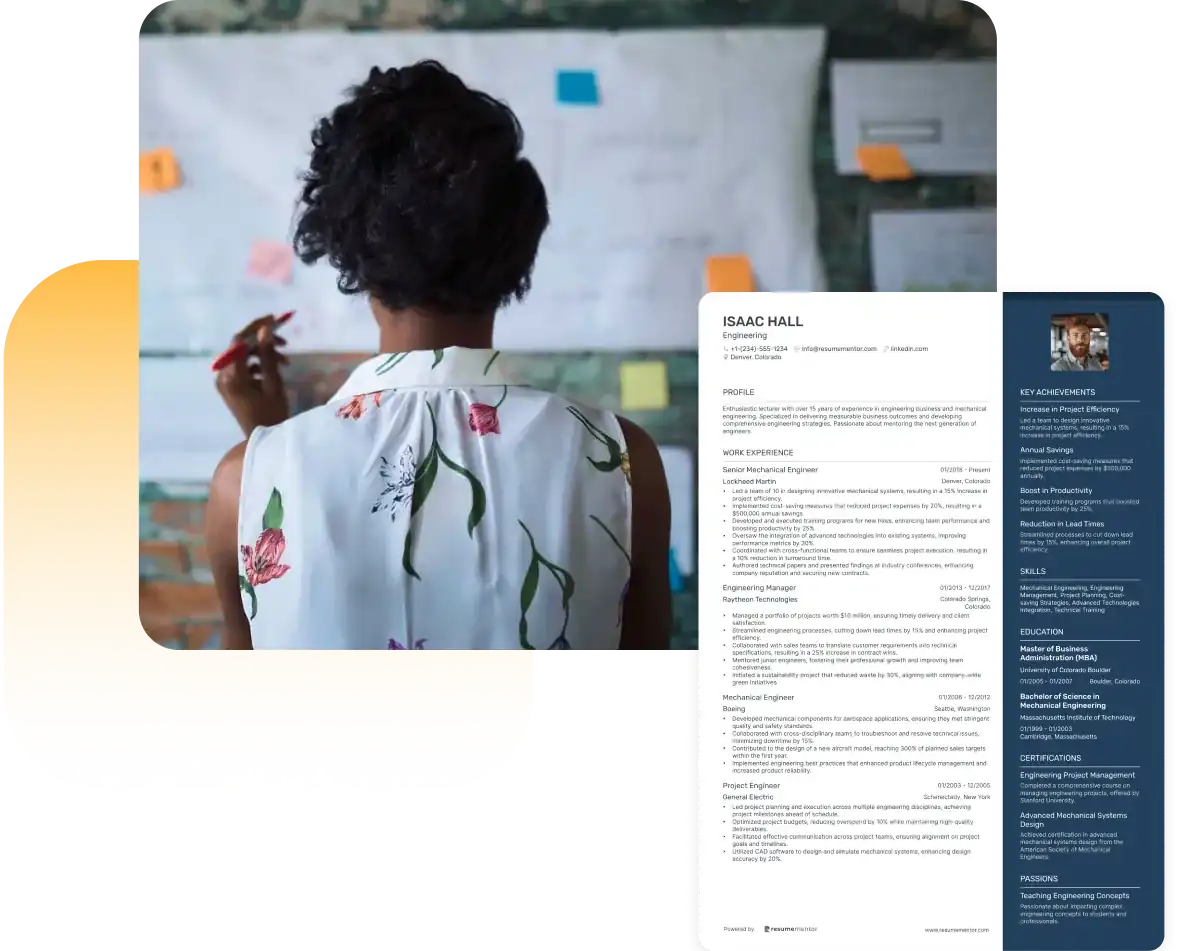
Continue Reading
Check more recommended readings to get the job of your dreams.
Resume
Resources
Tools
© 2025. All rights reserved.
Made with love by people who care.

